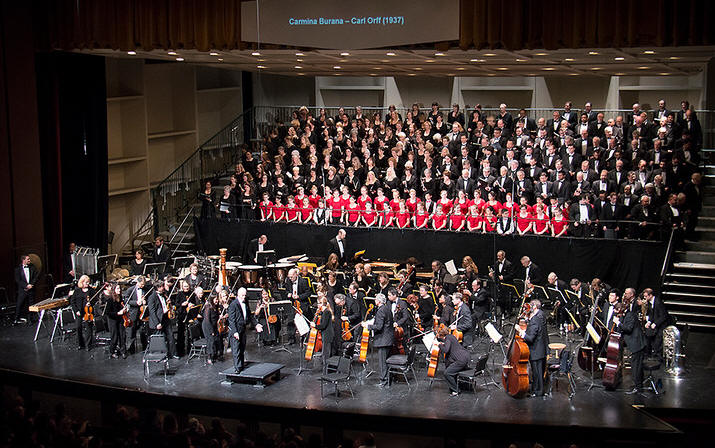Concert Review
Sacramento Choral Society & Orchestra
Carmina Burana - March 5, 2016
It was a dark and stormy night ………… but that didn’t dampen the spirits of the sixteen-hundred-plus people who turned out for Sacramento Choral Society & Orchestra’s 2016 production of Carmina Burana by Carl Orff, the American Premiere of English composer Jonathan Dove’s Psalms for Leo, excerpts from Karl Jenkins’ Adiemus: Songs of Sanctuary, and the 1932 Los Angeles Olympics’ Silver Medal in Music winner, “Towards a New Life,” by Josef Suk.
The evening actually started with a pre-concert talk by Music Director and Conductor, Dr. Donald Kendrick. This was an opportunity to get to know a little about the composers, their works and the historical setting in which they were composed. This particular talk was partly a dramatic presentation of some of the poetry of Carmina and partly a discussion of the historical setting. Even though the poems were written in medieval times, the songs were set by Orff in the 20th century—ancient lyrics with contemporary music. Orff actually considered Carmina his crowning glory and felt everything he composed prior to it could be destroyed. The talk greatly enhanced my anticipation of the program that followed.
(Click here to open the concert program in a new window.)
After the pre-concert talk and a brief interlude, Dr. James McCormick, SCSO Board President, introduced the entire audience to the evening’s special program, thanked us for our support, and then explained the dedication of the program in memory of long-time tenor chorister, Ed Humphrey. And from what I heard at the intermission, he was a special person who will be sadly missed by so many people.
One of the most important things that can be said about this concert is that the music chosen for this production was overwhelmingly accessible to lovers of all genres of music. Classicists and modernists alike would have been delighted. There was music with medieval lyrics set to contemporary music; songs of praise, patriotic marching music; lyrics that made you laugh; music with lyrics, but no words; music in several languages (with projected supertitles); new music with old themes, and Celtic dance set to music with an African beat. SCSO gave us choral music by and for adults and children, instrumental music, solo pieces, ethnic dance, and operatic theater. Every group had a starring role. It was as complete a program as possible. Bravo SCSO and guest performers!!
This program was highlighted by the soloists who were vocally and expressively well cast in their roles in Carmina Burana. The choruses were so sharp in their articulation and diction, that I could actually hear the words, no small feat for a large choir. The children were stand-outs as the most expressive singers of all (thanks to Director Lynn Stevens for her guidance). I was also very impressed with the orchestra. They were a constant support for the singers, as well as a stand-alone entity for the instrumentals. There were no obvious issues with rhythm, notes, entries, cut-offs or unisons. They played with a comfortable assurance and pleasurable exuberance.
Adiemus is a series of vocalise-style albums by contemporary Welsh composer Karl Jenkins. Each Adiemus album is a collection of song-length pieces featuring harmonized vocal melody against an orchestra background. There are no lyrics as such; instead the vocalists sing syllables and ‘words’ invented by Jenkins. This language is carefully stylized so as not to distract the listener's attention from the pitch and timbre of the voice. The core concept of Adiemus is that the voice should be allowed to function as nothing more than an instrument. The musical language of Adiemus draws heavily on classical and world music, but the harmony is derived from gospel and African music. The percussion section gives the pieces an upbeat, tribal-like rhythm. The sound of Adiemus is generally identified with New Age or Celtic music.
“Hymn” and “Caelum Fero” were the two songs chosen from the album, Adiemus: Songs of Sanctuary. With orchestration that sounded like chirping birds and chapel bells, “Hymn” began with a ‘word’ that sounded like “Yeh.” The children’s choir sang beautifully, befitting this warm, mellow, hymn-like piece, which ended with a short solo. I wanted to hear this song again!
“Caelum Fero” (“to the wild heavens”), was sung by the entire choir and danced by Nicole McKeever and two of her students, Laura Gorry and Moriah Payne, from the McKeever School of Irish Dance. Despite the very limited amount of space, the choreography was filled with spirited high leaps and intricate steps, which mimicked the exuberance of the African beat and the nonsense syllables of this piece.
|
|
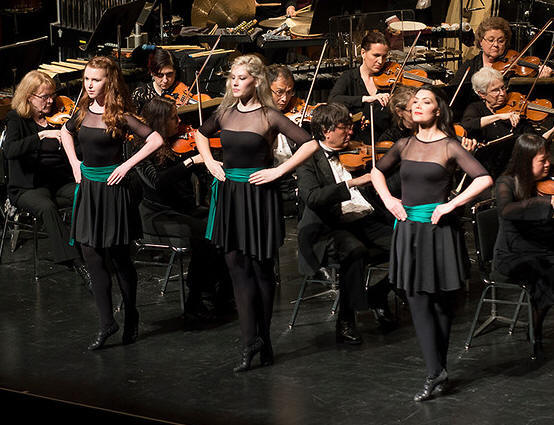 |
Towards a New Life is an instrumental composition by contemporary Czech composer, Josef Suk, who died in 1935. This piece began with a brilliant, uplifting patriotic fanfare dominated by percussion and horns. Originally the 1919 festive march, Into a New Life, Suk revised the work and submitted it to the Art Competitions of the 1932 Summer Olympics in Los Angeles, where it won a silver medal in the Music category. What a fitting processional this would have been for the Olympics, but competition entries were on paper only; Suk’s piece was never played at the Olympics. (1936 marked the only occasion when the winning musical works were actually played before an audience.) Then during WWII, the opening fanfare of Towards a New Life was used as the radio signature for broadcast of the Czechoslovakian Government in exile.
Suk said of himself: "I do not bow to anyone, except to my own conscience and to our noble Lady Music… and yet at the same time I know that thereby I serve my country ….”
This evening’s performance of contemporary English composer Jonathan Dove’s Psalms for Leo was an American premiere. It was conductor David Hill’s idea to celebrate the memory of Leopold de Rothschild (a singing member of the London Bach Choir for 50 years) by commissioning a setting of psalms, in Hebrew, for adult choir, children’s choir and orchestra. Jonathan Dove used the original Ancient Hebrew texts which acknowledged Leo’s Jewish heritage, while the psalms themselves are also a significant part of Christian tradition.
Because opera and the voice have been the central priorities in Dove’s output throughout his career, it is not really surprising that his orchestral music would be full of drama and seem larger than life. The first movement, “Psalm 148,” employed the full orchestra, adult and children’s choirs. The cacophony of sound was like multiple choirs praising God from entities around the world, from sea monsters to mountain cedars, from old men to children, above heaven and above earth. Even the ancient Hebrew with its strong consonants and guttural sounds enhanced this feeling of exhilaration. In contrast “Psalm 27” was soft, melodic, and contemplative. The final movement, “Psalm 19,” was mysterious, then frenetic, with a serene ending—as if everyone ascended into heaven. And this was just the first half of the program!
 |
 |
Carmina Burana is the name given to a manuscript of 254 poems and dramatic texts mostly from the 11th, 12th, and 13th centuries. The pieces are mostly bawdy, irreverent, and satirical. Mostly an anonymous work, the text of Carmina appears to have been written by Goliards and vagrants—mainly clerics at or from the universities of France, Germany, Spain, Italy, and England who protested the growing contradictions within the Catholic Church through song, poetry and performance. They seemed to have an attitude towards life and the world that stands in stark contrast to the firmly established expectations of life in the Middle Ages.
Carl Orff’s composition, Carmina Burana, was intended as a staged work involving dance, choreography, visual design and other stage action. Written in 1935 and 1936 and based on 24 poems from the medieval collection of the same name, the piece is now usually performed as a scenic cantata. Its full Latin title is Carmina Burana: Cantiones profanæ cantoribus et choris cantandæ comitantibus instrumentis atque imaginibus magicis ("Songs of Beuern: Secular songs for singers and choruses to be sung together with instruments and magic images").
Carmina Burana is structured into five major sections, containing 25 movements in all (Movements 1 and 25 being the same): In Springtime, On the Lawn, In the Tavern, The Court of Love, and Blanchefleur and Helen. Fortune, Empress of the World make up the introduction and the finale. The selection of Latin, German and French poems covers a wide range of topics: the fickleness of fortune and wealth, the ephemeral nature of life, the joy of the return of spring, love, and the pleasures and perils of drinking, gluttony, gambling and lust. Although Orff’s 20th century orchestration shows the influence of the late Renaissance and early Baroque, the excitement of the rhythms, the romantic intensity, and the harmonic simplicity show deference to Igor Stravinsky.
Carmina is full of intensity, nuances, and crazy rhythms which need to be strictly executed and fully expressed by the choruses, the orchestra, and the soloists. It takes complete attention to detail and this group of musicians had it all. From conductor Dr. Donald Kendrick’s precise direction, to Tod Brody’s short, rhythmic flute solo in “Tanz,” everyone performed exquisitely. It was as if Orff wrote Carmina to allow every group to shine. Some of the highlights follow.
Starting with “O Fortuna,” the orchestra never lagged in tempo, the rests between words sung by the choir were perfectly in unison; there were no hangers-on, and the strict rhythm was driving. This was a good omen for the 70-minute program that was to follow. When they repeated “O Fortuna” as the finale, they were still strong. I didn’t detect any dragging or letting down of intensity. I loved the second movement, with voices and instruments mimicking each other like a conversation. The men were particularly strong. The "On the Lawn" section brought us the instrumental “Dance” (I would have liked to have seen the Irish dancers here or elsewhere in Carmina), followed by a song about a lover fleeing on horseback, vividly showcased by the orchestra, with a nice light, lilting tone from the women. Sung by the women’s choir, “Shopkeeper, give me colour” was flirty, funny and sung with very distinct, sharp staccati and lovely unisons. In the tenth movement, the orchestra gave us a trumpet fanfare to enhance the dream of being with the Queen of England.
A "crying-in-his-beer" baritone solo started "In the Tavern"; it was fast, articulate, fun, with a strong orchestral accompaniment. This was followed by tenor soloist, Brian Staufenbiel, singing the hilarious, swan song, “Cignus ustus cantat.” Clad in white feathers, he shed them as he sang “Now I lie on a plate, and cannot fly anymore …. Misery me …!” To express this misery required him to sing falsetto throughout most of the song. After the croaking swan, Lee Poulis’s baritone voice was rich and smooth as he sang, “I am the abbot of Cockaigne and my assembly is one of drinkers ….” Mr. Poulis’s role was difficult, because the range of some of his solos was really beyond that typical for a baritone. Then there were a couple more drinking and gambling songs.
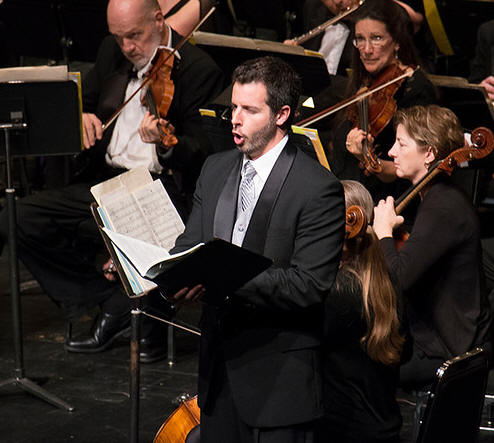 |
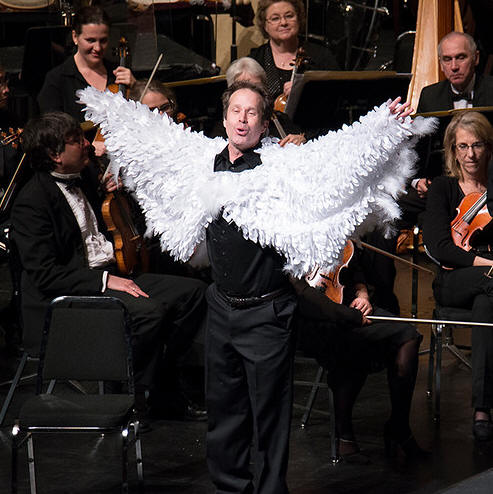 |
The "Court of Love" section began with a beautiful aria by lyric soprano, Shawnette Sulker, who sings about a girl without a lover missing all the pleasures. The sustained note at the end of this piece was breathtaking. This was followed by a humorous, "woe-is-me" baritone solo, where he bounces between his true voice and his falsetto voice. Another vocal feat! “A girl stood in a red tunic,” the soprano solo that followed, was flirty and gorgeous. Ms. Sulker was well cast for this soprano role. Her “In Truitina” was sweetly sung and “Dulcissime” was pure heaven as she enticingly sang, “Sweetest one! Ah! I give myself to you totally!” which required her to sing the D above high C after leaping two octaves!!!
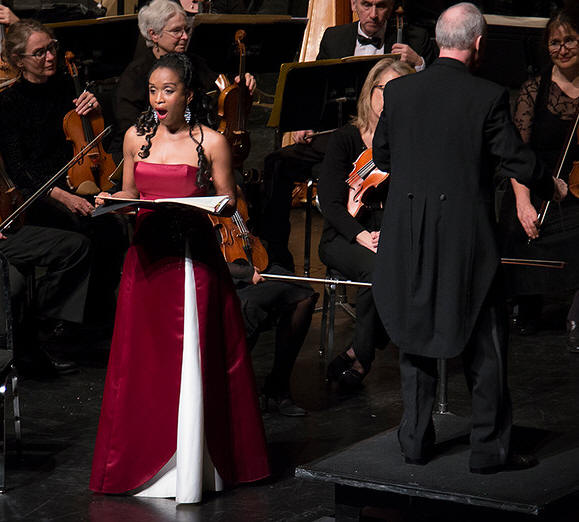 |
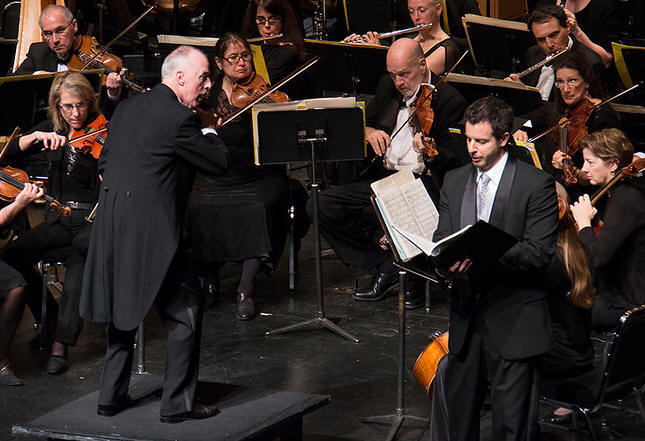 |
Most of Orff’s solo pieces in Carmina were obviously challenging. That’s not to lessen the difficulties of the choir, who had to contend with changing rhythms, fast movements, contrasting dynamics and the very important details of unisons. The choir needed to be large, but still sound as one voice, with the quick entries, sharp staccati and cut-offs sung together. These three choirs (Sacramento Choral Society, Sacramento State University Chorus, and Sacramento Children’s Chorus) were a tight ensemble. I sometimes wished that the choir had been even larger, because Carmina is very demanding and the exuberant orchestra sometimes overpowered them. However, I don’t know where more singers would have stood.
My notes were full of smiley faces: for the soloists, for the children, and for the precision of the choir and orchestra. Although not all choral entities can afford such productions, and not everyone can afford to attend performances at the Sacramento Community Center, if you ever have the opportunity to hear any of the masterpieces on this program, I urge you to do so. It will be well worth your time and will lift your spirits immensely.
